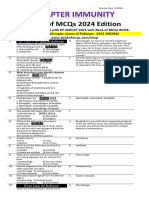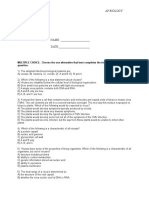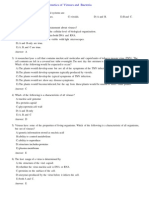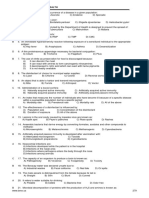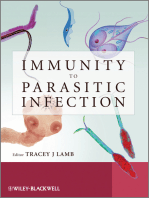Microcreds 2011
Microcreds 2011
Uploaded by
HavardKrovelCopyright:
Available Formats
Microcreds 2011
Microcreds 2011
Uploaded by
HavardKrovelOriginal Title
Copyright
Available Formats
Share this document
Did you find this document useful?
Is this content inappropriate?
Copyright:
Available Formats
Microcreds 2011
Microcreds 2011
Uploaded by
HavardKrovelCopyright:
Available Formats
1.
Transmission of genetic information bewixt cells with the help of bacteriophage is called
a) Transduction x
b) Transformation
c) Conjugation
d) Translation
2. Tetracyclin is an antibioticum of choice for infections
a) in children
b) zoonosis caused by intracellular bacteria
c) with bacteriocidic activity x
d) caused by parasites
3. Lysogenic bacterium
a) carries a prophage x
b) causes lysis of other bacteria
c) can't support the replication of virulent phage
d) is a human pathogen
4. Which of mentioned is used to treat bladder infections caused by G-negative rods (E.Coli)
a) penicilin
b) sulfonamides x
c) izoniazid
d) oxacilin
5. The forst antistaphylococcal penicilin antibioticum – still efficient in most of staphylococcus
aureus in Slovakia – with emerging resistance that can be cause of severe hospital infection problem
is
a) methicilin x
b) penicilin
c) erytomycin
d) tetracyclin
6. Which of the following contains peptidoglycans
a) ribosomes
b) gram-positive cell walls only
c) flagella and all bacterial cell walls
d) gram-negative cell wall and b) x
7. Encapsulated bacteria
a) are sometimes more virulent than their non encapsulated counterparts x
b) are more susceptible to phagocytic destruction
c) are easier to swallow than tablet bacteria
d) are more resistant than viruses
8. Exotoxin of Clostridium Tetani is the tool of
a) virulence
b) pathogenicity
c) infection
d) immunity x
9. Transformation as a process of transmission of free genetic information was described by
a) Griffith, during study of encapsulated and nonencapsulated strains of Streptococcus
Pneumoniae x
b) Lancefield during the study of cell wall antigens of streptococci
c) Bergey during preparation of the system of bacteria
d) Loowenhoed when studying microbes in the microscope he produced
10. Penicilin antibiotics are not toxic to human because
a) they are produced by eatable fungi
b) they have a simple structure
c) they do not cross the intestine barrier
d) they are efficient on the level of cell wall structures x
11. Spherical bacteria arranged in a chain are known as
a) spiromhmhm
b) staphylococci
c) streptococci x
d) streptobacilli
12. A microorganism that is commensal
a) does not recieve any benefit from its host
b) is harmful to its host
c) receives benefit from its host x
d) none of the above describe a commensal bacteria
13. Which of mentioned inactivates beta lactamases
a) penicilin
b) clavulanic acid x
c) ampicilin
d) cephalosporins
14. Target structure of penicilin antibiotics is not present on animal cells because it is part of
a) cell wall x
b) plasmatic membrane
c) mictochondria
d) nucleic acids
15. Cell membranes are composed primarily of
a) protein and polysaccharides
b) peptidoglycan in prokaryotes
c) protein and phospholipid x
d) phospholipd and polysaccharides
16. The segments of DNA transferred bewixt cells are
a) large
b) small
c) circular x
d) not functional
17. The site of protein synthesis in prokaryotic cells
a) are in the mitochondria
b) is the LPS
c) is the cell membrane
d) are the ribosomes x
18. Conjugation is the transmission of genetic information via
a) flagella
b) pillus x
c) contact of plasmatic membrane
d) contact of VAP (Virus Attachment Protein)
19. Which of the following structures is unique to prokaryotic organisms
a) mitochondria
b) cell membrane
c) peptidoglycan cell wall x
d) ribosomes
20. Physiological flora of skin is
a) Candida Albicans and Streptococcus Pneumoniae
b) Viridant cocci and Corynebacterium Diphteriae
c) Staphylococcus Epidermis, Proponibacter Acnes x
d) no answer is correct
21. Protective against intrauterine infections are antibodies type
a) IgG
b) IgM
c) IgE
d) IgA x
22. Antitoxin is x
a) antibody against toxin
b) immunogenicity deprived toxin
c) toxicity deprived toxin
d) the same as toxoid
23. Beta-lactames are antibiotics that are efficient at the level of
a) synthesis of cell wall x
b) synthesis of nucleic acid
c) proteosynthesis
d) metabolism of folic acid
24. Infectious disease have essentially been eliminated by antibiotics and vaccination and
are no longer a public health problem. This statement is
a) true
b) false x
c) is true for Europe
d) is true for your country
25. Leewenhock's discoveries were significant because
a) he was the first scientist in the world
b) he used microscope and carefully recorded and reported his results
c) he used lenses to visualize bacteria x
d) he was the first microbiologist
26. Penicilin antobioticum with increased efficiency to gram-negative bacteria is
a) oxacilin
b) meticilin
c) ampicilin x
d) oxolin acid
27. What type of antibodies are protective and important to eliminate a bacterium in
encapsulated strains
a) opsonising antibodies
b) antitoxic antibodies x
c) neutralizing antibodies
d) immunocomplexes
28. Translation is also known as
a) DNA synthesis
b) protein hydrolysis
c) reverse transcription
d) protein synthesis x
29. Resistance to many antibiotics is transferred by genetic information present in
a) sex pilli
b) plasmids x
c) fimbriae
d) enzymes
30. The metabolites that activate gene transcription are called
a) synthesizers
b) operators
c) inducers
d) promoters x
31. Endotoxin
a) is extremely immunogenic
b) stimulate production of precipitating antibodies
c) is a part of gram-negative cell wall x
d) is a part of gram-negative plasma membrane
32. When bacteria develop resistance to an antibiotic, the antibiotic does not caise the
mutation but only selects for a preexisting mutation (wat?)
a) true x
b) false
33. Virulence of the bacterium with Lethal Dose (LD) 50 = 1000
a) is lower than virulence of a microbe with LD = 100000
b) is higher than virulence of a microbe with LD = 100000 x
c) can't be guessed from this
d) means that this dose will kill 50 bacteria of 1000 exposed
34. Which of mentioned can cause aplastic anemia
a) chloramphenicol x
b) penicilin
c) clavulanic acid
d) chinolones
35. The cell wall of gram-positive bacteria is composed of
a) cellulose
b) starch
c) peptidoglycan x
d) chitin
36. Lipopolysaccharide og gram-negative bacteria activates complement by
a) alternative way
b) classical way x
c) lectin way
d) only in presence of opsonising antibodies
37. The group of bacteria that do not have cell walls are
a) archaebacteria
b) mycoplasma x
c) eubacteria
d) mycobacteria
38. Cells that do not have a membrane separating their nuclear material from their cytoplasm
are called
a) heterozygotes
b) prokaryotic x
c) eukaryotic
d) viruses
39. Ability to produce disease in infected human is called
a) pathogenicity
b) virulence x
c) resistance
d) infectiousity
40. Endotoxins belong to a class of biological molecules called
a) mucopolysaccharides
b) lipopolysaccharides x
c) nucleic acids
d) proteins
You might also like
- Test Bank For Microbiology Basic and Clinical Principles 1st Edition Lourdes P Norman MckayDocument8 pagesTest Bank For Microbiology Basic and Clinical Principles 1st Edition Lourdes P Norman MckayJoseph Williams98% (42)
- Microbiology Midterm ExamDocument8 pagesMicrobiology Midterm Examslg23350% (2)
- Teaching Plan For CapDocument4 pagesTeaching Plan For CapLorieAnnBringas50% (4)
- Test Bank For Brock Biology of Microorganisms 13th Edition MadiganDocument8 pagesTest Bank For Brock Biology of Microorganisms 13th Edition MadiganjendengrawrNo ratings yet
- MicrobiologyDocument99 pagesMicrobiologyYu Liang100% (1)
- Athangazcmccjx21x0ahzw1s PDFDocument3 pagesAthangazcmccjx21x0ahzw1s PDFChitranshu WaghNo ratings yet
- Stephen Toulmin, The Tyranny of PrincipleDocument10 pagesStephen Toulmin, The Tyranny of PrinciplepbfriedmanNo ratings yet
- UHS Biology Most Repeated McqsDocument24 pagesUHS Biology Most Repeated Mcqstcs440734No ratings yet
- 6th TestDocument15 pages6th Testownwillprincess2No ratings yet
- Question Bank - Unit 3 - BiologyDocument13 pagesQuestion Bank - Unit 3 - Biologym.k.rameshkumar1No ratings yet
- T. Y. Sem. VI, Pharm Biotech (R-2019)Document18 pagesT. Y. Sem. VI, Pharm Biotech (R-2019)Usman KhanNo ratings yet
- BIOL 3332 Unit 1 Practice QuestionsDocument10 pagesBIOL 3332 Unit 1 Practice QuestionsJoseph Garcia0% (1)
- Work Sheet 1 C D 5 21 23 PDFDocument4 pagesWork Sheet 1 C D 5 21 23 PDFfelipe.arroyo4996No ratings yet
- Class 11 Biology Assignment Chapter 2 Biological ClassificationDocument6 pagesClass 11 Biology Assignment Chapter 2 Biological ClassificationGarisha VirdiNo ratings yet
- Entrance 2017Document20 pagesEntrance 2017Ipsita NagNo ratings yet
- Chapter Immunity Mcqs by Study CornerDocument15 pagesChapter Immunity Mcqs by Study Cornerdr.rashidali12No ratings yet
- Uhs Topic - 8 BiotechnologyDocument3 pagesUhs Topic - 8 BiotechnologyHamzullah KhanNo ratings yet
- 12th Biology Set 3 Model Question Paper English Medium PDF DownloadDocument5 pages12th Biology Set 3 Model Question Paper English Medium PDF Downloaddekud9556No ratings yet
- Student Copy Test 9Document13 pagesStudent Copy Test 9Usama MukhtarNo ratings yet
- Biology Examination For Grade 12 Prepared by Thomas and DessalegnDocument6 pagesBiology Examination For Grade 12 Prepared by Thomas and Dessalegnkoket negashNo ratings yet
- Pu Cet (2017)Document11 pagesPu Cet (2017)Arushi PatiyalNo ratings yet
- Full Length BiologyDocument7 pagesFull Length BiologyKeerti singhNo ratings yet
- Biology Assignment XI Ch-2 Biological ClassificationDocument9 pagesBiology Assignment XI Ch-2 Biological ClassificationPoonam MeenaNo ratings yet
- Score: Ap BiologyDocument11 pagesScore: Ap BiologydfngjlnNo ratings yet
- Chap 021Document10 pagesChap 021Ondape ValeryNo ratings yet
- Question SetDocument140 pagesQuestion SetPiyush Ranjan BeheraNo ratings yet
- Prokaryotic DiversityDocument2 pagesProkaryotic DiversityHadia SaeedNo ratings yet
- MCQs On DNA Technology and GenomicsDocument13 pagesMCQs On DNA Technology and Genomicsronojoysengupta88% (8)
- ABT 301-Plant Biotechnology (2+1) - Question Bank 1Document5 pagesABT 301-Plant Biotechnology (2+1) - Question Bank 1Mahima RajaNo ratings yet
- Grand Test XiDocument16 pagesGrand Test XiAliNo ratings yet
- Class12 - Biotec-Principle Ans ProcessesDocument13 pagesClass12 - Biotec-Principle Ans ProcessesSai SaranNo ratings yet
- 620biology QB Xii 23-24 Term 1Document23 pages620biology QB Xii 23-24 Term 1Jiya PandeyNo ratings yet
- DPP - Human Health & Disease by Seep PahujaDocument11 pagesDPP - Human Health & Disease by Seep PahujamilanbhongadeNo ratings yet
- Biological Classification QuestionDocument7 pagesBiological Classification QuestionSatyam PandeyNo ratings yet
- Unit 1 Test - GRB Question BankDocument10 pagesUnit 1 Test - GRB Question BankSujata UpadhyeNo ratings yet
- Chapter 18Document10 pagesChapter 18nehallakdawalaNo ratings yet
- Microbiology Question Bank-1Document40 pagesMicrobiology Question Bank-1Abd El-Rahman SalahNo ratings yet
- Sample Exams To Post 2019 PDFDocument32 pagesSample Exams To Post 2019 PDFDustin SuttonNo ratings yet
- 11 Biology - Full Book MCQsDocument8 pages11 Biology - Full Book MCQsAbbas HaiderNo ratings yet
- CHAPTER Acellular LifeDocument4 pagesCHAPTER Acellular LifeRahila Akram100% (1)
- Agriculture Biotechnology McqsDocument3 pagesAgriculture Biotechnology McqsMinahil AtharNo ratings yet
- Biology Test-1Document3 pagesBiology Test-1Satyam PandeyNo ratings yet
- Micro MCQDocument26 pagesMicro MCQabdulNo ratings yet
- 2012 Tortora - 11thDocument15 pages2012 Tortora - 11thaddNo ratings yet
- Mod 6 Combined PacopDocument103 pagesMod 6 Combined PacopJacosby WorcestershireNo ratings yet
- Microbio PDFDocument17 pagesMicrobio PDFHernandez IanNo ratings yet
- All MCQDocument20 pagesAll MCQYASH DESHMUKH 66No ratings yet
- 00047998-Microbiology Final Reworked Edition1Document390 pages00047998-Microbiology Final Reworked Edition1Diaz ShehanNo ratings yet
- 12 Biology Eng PP 2023 24 2Document5 pages12 Biology Eng PP 2023 24 2Taufeeque SifatNo ratings yet
- 12-Quiz 2 Model questions-13-Jan-2020Material - I - 13-Jan-2020 - QUIZ - PREP-VECTORSDocument13 pages12-Quiz 2 Model questions-13-Jan-2020Material - I - 13-Jan-2020 - QUIZ - PREP-VECTORSArarsoNo ratings yet
- Biology MQ XiiDocument67 pagesBiology MQ XiiAditya Mohan GuptaNo ratings yet
- Adejoh MCB 201 (Questions and Answers) ? ????Document57 pagesAdejoh MCB 201 (Questions and Answers) ? ????hhude65No ratings yet
- Solved MCQsDocument3 pagesSolved MCQssaman iftikharNo ratings yet
- Module 8 MCQDocument6 pagesModule 8 MCQQairul AzmanNo ratings yet
- Cancer Gene Therapy by Viral and Non-viral VectorsFrom EverandCancer Gene Therapy by Viral and Non-viral VectorsMalcolm BrennerNo ratings yet
- Topical Guidebook For GCE O Level Biology 3 Part 2From EverandTopical Guidebook For GCE O Level Biology 3 Part 2Rating: 5 out of 5 stars5/5 (1)
- Microbial Proteomics: Functional Biology of Whole OrganismsFrom EverandMicrobial Proteomics: Functional Biology of Whole OrganismsNo ratings yet
- Immunity to Parasitic InfectionFrom EverandImmunity to Parasitic InfectionTracey LambNo ratings yet
- Reseptor AdrenergikDocument3 pagesReseptor AdrenergikAhmad Ikbal PurnawarmanNo ratings yet
- PG 2017Document1 pagePG 2017SowmiyaNo ratings yet
- Laporan Biologi Molekuler Isolasi DNA MukosaDocument2 pagesLaporan Biologi Molekuler Isolasi DNA MukosaRosyadiAdnanNo ratings yet
- Salmodil Syrup: What Is in This LeafletDocument2 pagesSalmodil Syrup: What Is in This LeafletNadia SalwaniNo ratings yet
- Acid Base Imbalance PDFDocument32 pagesAcid Base Imbalance PDFdr.Bobi Ahmad Sahid, S.KepNo ratings yet
- Efektifitas Penggunaan White Petroleum Jelly Untuk Perawatan Luka Tekan Stage 1 Di Ruang Di Rawat Inap Siloam Hospitals Lippo VillageDocument18 pagesEfektifitas Penggunaan White Petroleum Jelly Untuk Perawatan Luka Tekan Stage 1 Di Ruang Di Rawat Inap Siloam Hospitals Lippo VillageShafa AudryNo ratings yet
- Chapter 1 RespirationDocument26 pagesChapter 1 RespirationaqilajandinNo ratings yet
- DM Conclusion 222Document2 pagesDM Conclusion 222DrDeepak PawarNo ratings yet
- POPM IndianJAnaesth505345-128624 - 000208Document10 pagesPOPM IndianJAnaesth505345-128624 - 000208venkayammaNo ratings yet
- Relaxation Techniques Dominic S. Adolfo: Relax The Body and The Mind Will Follow!Document33 pagesRelaxation Techniques Dominic S. Adolfo: Relax The Body and The Mind Will Follow!Gerrold BautistaNo ratings yet
- CPD + MakrosomiaDocument6 pagesCPD + MakrosomiaLili SurianiNo ratings yet
- Lemongrass EfficiencyDocument3 pagesLemongrass EfficiencyAji Deonella Tangcangco CruzNo ratings yet
- Zakon o Medicinskim-Sredstvima EngleskiDocument93 pagesZakon o Medicinskim-Sredstvima EngleskiSlaviša ŠimetićNo ratings yet
- A Comparison Between TCM and Dr. Tan's Balance Method PDFDocument46 pagesA Comparison Between TCM and Dr. Tan's Balance Method PDFCeline de Haan100% (9)
- Chaucer, The Canterbury TalesDocument3 pagesChaucer, The Canterbury TalesGiorgio MicuNo ratings yet
- 2.6.8 - EU 9.0 PyroDocument2 pages2.6.8 - EU 9.0 PyroLEPESANTNo ratings yet
- Specialization Final O-09 PDFDocument33 pagesSpecialization Final O-09 PDFAnagha BhatkarNo ratings yet
- Radiesse For Aesthetic Soft Tissue Augmentation PDFDocument7 pagesRadiesse For Aesthetic Soft Tissue Augmentation PDFfishvalNo ratings yet
- 04telkom OkDocument248 pages04telkom OksilvaniNo ratings yet
- Atlas of Small Animal UltrasonographyDocument1 pageAtlas of Small Animal Ultrasonographyiuliapopescu305No ratings yet
- Malignant HyperthermiaDocument7 pagesMalignant HyperthermiaarbntmareNo ratings yet
- Sample Chapter 8 Therapeutic ExerciseDocument29 pagesSample Chapter 8 Therapeutic ExerciseAnsh TanwarNo ratings yet
- AdvertisementDocument7 pagesAdvertisementDaniyal khanNo ratings yet
- Final ResumeDocument4 pagesFinal Resumeapi-484529951No ratings yet
- Efficacy of Feracrylum As Topical Hemostatic Agent in Therapeutically Anticoagulated Patients Undergoing Dental Extraction: A Comparative StudyDocument5 pagesEfficacy of Feracrylum As Topical Hemostatic Agent in Therapeutically Anticoagulated Patients Undergoing Dental Extraction: A Comparative StudyDr.Sudarsan SenNo ratings yet
- Department of Gastroenterology and Hepatology: Student's Name: SALLY GAZMAWIDocument7 pagesDepartment of Gastroenterology and Hepatology: Student's Name: SALLY GAZMAWIConstantin VascautanNo ratings yet
- NotesDocument714 pagesNotesJess Simbulas100% (2)















